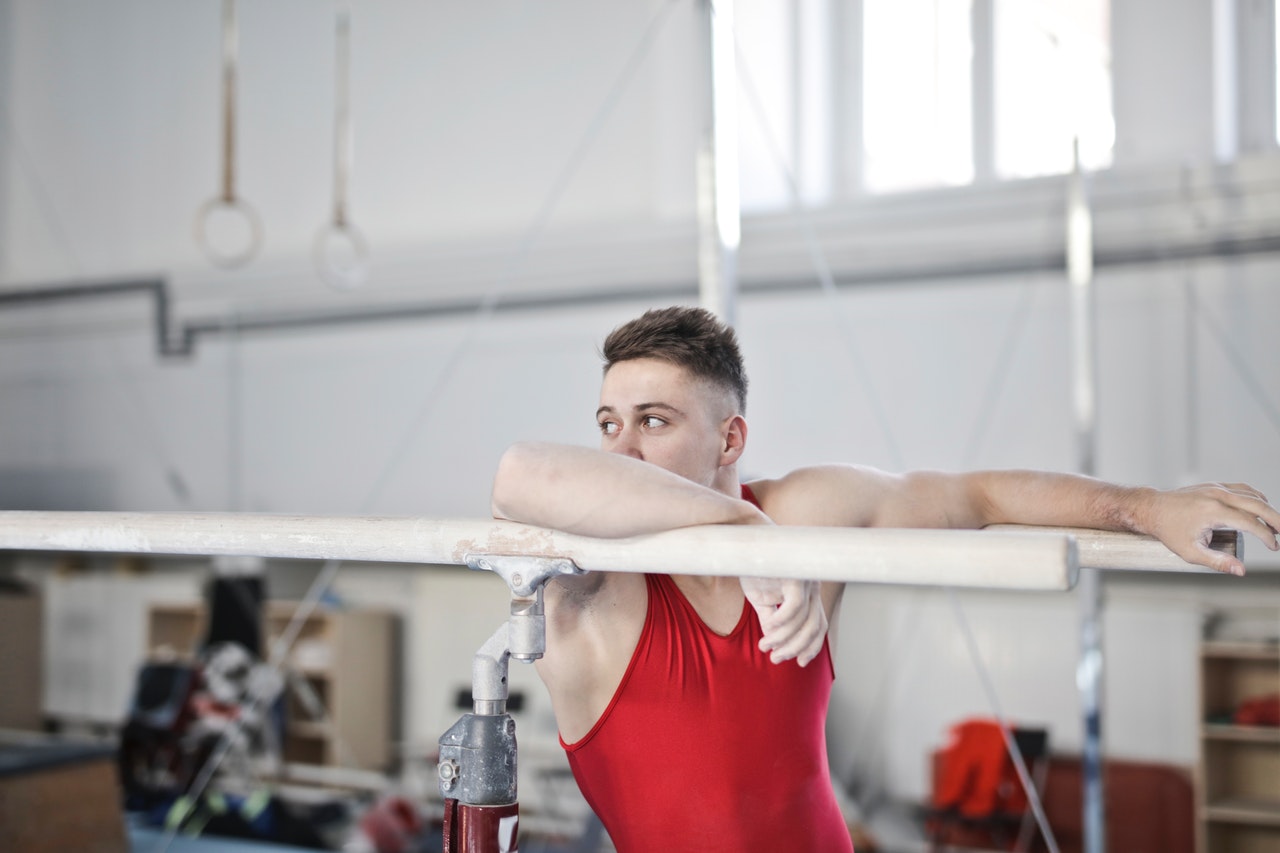
With an active, healthy lifestyle, there comes a risk of injury with basically any sport or exercise activity. If we use and overuse our bodies, there is always a risk of injury. However, we believe injury and sickness associated with a sedentary lifestyle are far greater than those of an active lifestyle! For that very reason, we want to share some advice about how to be proactively safe and prevent sports injuries with your active lifestyle and sports activities.
As with many sporting activities, there are common risks for injury among gymnasts. This past spring and summer, we held weekly workshops with a group of young male gymnasts. We worked with them twice a week for a two month period. At the beginning of our time with them, we completed detailed assessments of each athlete and we repeated those assessments at the conclusion of our time with them.
Based on some of the common faults and tendencies, we created a program that included a variety of stretches and strengthening exercises specific to their needs. While there was still improvement to be made on many levels, we saw noticeable improvements in all of the athletes by the end of the summer.
In this blog we will briefly touch on the initial issues we encountered, the program we used to address those issues, and finally the progress we saw. All of the stretches and strengthening exercises we used with the athletes are scalable and applicable to all gymnasts.
Upon initial evaluation, we completed a Functional Movement Screen and additional postural assessments on each gymnast. The FMS provides a snapshot of strengths and weaknesses in relation to the probability of injury. Any score lower than 67% on the FMS lists an athlete as high risk. Approximately 50% of our athletes initially scored in that range, putting them at high risk for injury.
We noted a few common deficiencies that needed to be addressed but narrowed them down in an effort to make a difference in a short amount of time. The gymnasts tended to have an overdeveloped upper body and chest and an overall weakness in the lower body relative to the strength of their upper body. Overdeveloped upper body and chest led to negative changes in posture, abnormal scapular position, as well as shoulder mobility restrictions. Such lack of mobility in shoulder joints can lead to more pain and frequent sprains of ligaments related to the shoulder.
Ballistic (quick, impactful) movements worsen these injuries. If a shoulder is relatively immobile and stabilizer muscles are weak, the athlete will be more prone to injury in movements that are highly demanding on the shoulders, such as on rings, pommel, vault, and high bar.
Compared to their upper body strength, the gymnasts had a tendency to be underdeveloped in their lower body. Most of the gymnasts presented with tightness in hip flexors, quads, and calves and weakness in hamstrings and glutes (this would be related specifically to the focus of their landings and tightness of positioning).
Ballistic movements increase the risk of injury when such imbalance and weakness are present. For example, due to tight hip flexors, proximal hip weakness, and untrained muscles, there was a general tendency for internal hip rotation to occur when sticking to a landing. Such a landing puts extra stress on those joints and ligaments, increasing the risk of injury. Calf tightness will directly affect the athlete’s stride into a tumbling pass as well as their “punch” to the ground before setting.
After detecting common weaknesses and imbalances, we chose to focus on the following general goals with the gymnasts:
Over the course of the two months, we created a program for the gymnasts which included a variety of stretching movements, strengthening exercises, and therapies for myofascial release. These are some of the various protocols we used with the athletes and are certainly ones we would suggest for any gymnast trying to successfully prevent injury:
STRETCHES: (can be easily performed at home with minimal equipment)
Band assisted (gymnasts can use either a stretch strap or resistance band)
Hamstring
Calf (medial)
Quadricep
Hip Flexors
Inner thigh
Wall assisted (can also be done using the floor as resistance for stretch)
Chest
Biceps
Lats
Triceps
STRENGTHENING EXERCISES: (can be easily performed at home with minimal equipment)
Shoulder exercises to strengthen stability and lesser-used muscles:
WITY’s with resistance
Internal and external shoulder rotation movement with resistance band
Snow angels - on the floor and against the wall
Core exercises:
Plank w/alternating legs
Hip bridges
V-ups
Other upper body strengthening movements:
Forward and Reverse flys
Overhead tricep extensions
Squat jumps - focusing on strengthening the lower body, but also training the landing
position to a more safe position
THERAPIES: (not recommended to do on your own at home, but can easily be performed by a professional or under the supervision of a professional. They are listed because they were a part of the overall program we used with our gymnasts.) Chiropractic adjustments were also performed as needed.
Chinese Cupping with movement - movement is done in an effort to fully free the tissue and work through any points of restriction
Cups placed on anterior/medial/posterior deltoids
Snow angels, arm circles (small and large)
Cups placed on Parascapular muscles
Snow angels, arm circles (small and large), flys, internal/external rotation of the shoulder, scapular protractions.
At the end of the two-month program with the gymnasts, many of the athletes had notable changes. Specifically, with the Functional Movement Screen, we went from 50% scoring at a high-risk injury rate to less than 15% scoring in that category. On average, athletes saw 20% improvement in testing on their left side and 25% improvement on their right side. In specific, we noted the following tangible changes:
The key component to injury prevention is being proactive with strengthening weaker muscles and stretching tight ones. Training to increase proprioception and the somatosensory systems is also of extreme importance. If athletes, regardless of the sport, only train certain muscle groups, they are setting themselves up for injury.
A gymnast who consistently stretches tight muscles will be less likely to injure those tight muscles. The same gymnast who consistently trains accessory work (as mentioned in this article) to strengthen weaker muscles, will be less likely to injure those muscles. Nearly all of our athletes moved out of the high-risk category in only 2 months of specified stretches and therapeutic exercises.
If you’ve experienced a gymnastics injury in Knoxville, please contact our office to schedule an appointment. We’d be happy to tell you more about our treatment options and get you back to optimal health.
----------------------------------------------------------------------
Articles used and referenced: (also good sources of athlete and parent education)
https://orthoinfo.aaos.org/en/staying-healthy/gymnastics-injury-prevention
https://orthoinfo.aaos.org/en/diseases--conditions/overuse-injuries-in-children

8029 Ray Mears Blvd, Suite 300
Knoxville, TN
37919
Phone: 865-337-5574
Monday
7am-12pm & 1pm-6pm
Tuesday
7am-12pm & 1pm-4pm
Wednesday
7am-1pm
Thursday
7am-12pm & 1pm-6pm
Friday
7am-12pm & 1pm-4pm
Saturday & Sunday
Closed